توفر الآبار المحفورة إمدادات مائية منخفضة التكلفة للأسر المعيشية الواحدة ، أو للمجتمعات الريفية الصغيرة، أو للمناطق الحضرية. مبدأ العمل بسيط نوعًا ما: يتم انشاء حفرة تصل الى مستوى المياه الجوفية ويتم بعد ذلك يتم تجميع المياه المرتشحة داخل الحفرة بواسطة مضخة يدوية أو آلية. عملية انشاء الابار سريعة ومختلفة التقنيات فالحفر البسيط متاح ويناسب معظم الظروف الجيولوجية. بالرغم من ان تقينات الحفر للأبار أقل تأثرًا بالتلوث للمياه الجوفية مقارنة بالأبار التقليدية ، فإن البناء الكافي وحماية البئر أمر حيوي لتحسين نظام إدارة المياه المحلية على المدى الطويل. يتعين الاهتمام الخاص لمعدل سحب المياة من البئر حتى لا تحدث تاثيرات بيئية وتداخل مع المياه المالحة (في المناطق الساحلية فقط). فإذا كان البئر فى مكان مرتفع جدًا، فقد يجف .
| المُدخلات | المُخرَجات |
|---|---|
المياة العذبة . مياة الشرب |
المياة العذبة , مياة الشرب |
2. القرع
يستخدم القرع بالطرق اليدوية إداة ثقيلة للقطع أو مطرقة مربوطة بحبل أو كابل ويتم إنزالها في الحفرة المفتوحة أو داخل الجدار المؤقت. وعادة ما يتم استخدام حامل ثلاثي القوائم لدعم الأدوات. وعن طريق تحريك الحبل أو الكابل صعوداً وهبوطاً، تكسر القطّاعة أو المطرقة التربة أو الصخور الموجدة في البئر، والتي يتم استخراجها بعد ذلك باستخدام النازح ( جردل او ما شابه ) كما هو الحال مع التثقيب باليد، يمكن استخدام جدار مؤقت من الصلب أو البلاستيك لمنع الحفرة من الانهيار. يجب إزالة هذا الجدار المؤقت عند تثبيت الجدران الدائمة للبئر . يصل الحفر بالقرع اليدوي عمومًا الى عمق 25 مترًا.
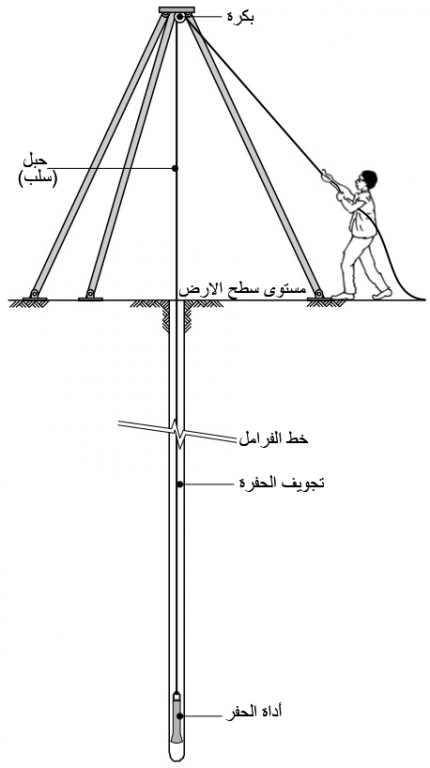
المصدر: ELSON & SHAW (1995)

3. ترسيب الطين
تستخدم عملية ترسيب الطين دوران الماء لجلب التراب المحفور إلى السطح. يتم نقل أنابيب الحفر صعودًا وهبوطًا. بالضرب لأسفل، يخفف تأثير مثقاب الحفر من التراب وبالضرب لأعلى، يتم إغلاق الجزء العلوي من الأنبوب باليد (أو الصمام)، وسحب المياه من خلال الأنبوب ونقل القطع إلى السطح. أما بالضربة التالية لأسفل، تفتح اليد (الصمام) الجزء العلوي من الأنبوب وينبثق الماء في حفرة أمام البئر. في هذه الحفرة، تنفصل القطع عن المياه وتستقر، في حين تفيض المياه من الحفرة مرة أخرى إلى البئر. يبقى البئر مفتوحًا نتيجة لضغط المياه. يمكن إضافة مغلظات (إضافات) إلى الماء لمنع انهيار الحفرة وتقليل فقدان المياه العاملة. يمكن استخدام تقنية ترسيب الطين حتى عمق 35 مترًا
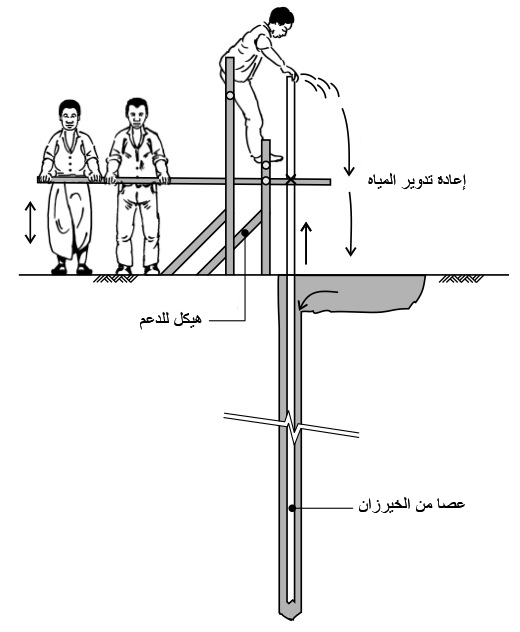
المصدر: ELSON & SHAW (1995)

4. الدفق
وتعتمد تقنية الدفق على دوران المياه وضغطها لاعلى . على عكس ترسيب الطين ، يتم ضخ المياه الى أسفل أنابيب الحفر. ويترتب على حجم المياه الكبير تآكل في القاع ويتم نقل "الطين" (الماء والقطع) بين أنبوب الحفر وجدار البئر. تستخدم مضخة يدوية أو آلية لتحقيق تدفق المياه الكافية. قد يكون أنبوب الحفر ذو نهاية مفتوحة، أو يمكن إضافة مثقاب ويمكن استخدام الدوران الجزئي أو الكامل من أنبوب الحفر. يمكن إضافة المغلظات (إضافات) إلى الماء لمنع انهيار الحفرة وتقليل فقدان المياه العاملة. يستخدم الدفق (مع الدوران) عمومًا حتى عمق 35 مترًا.
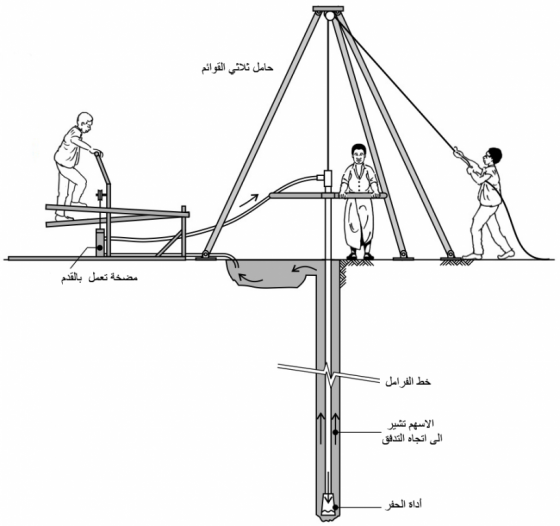
المصدر: ELSON & SHAW (1995)

5. الحفر الميكانيكي
طرق الحفر باستخدام المنصات المحمولة على المركبات تتكون من نوعين اساسين ، طريقة الحفر بالقرع أو وإحدى طرق التدوير الاخرى . كلا الأسلوبين لهما مميزات ، وقيود، وأداء، وملاءمة خاصة و للحصول على معلومات تفصيلية انظر WURZEL 2001
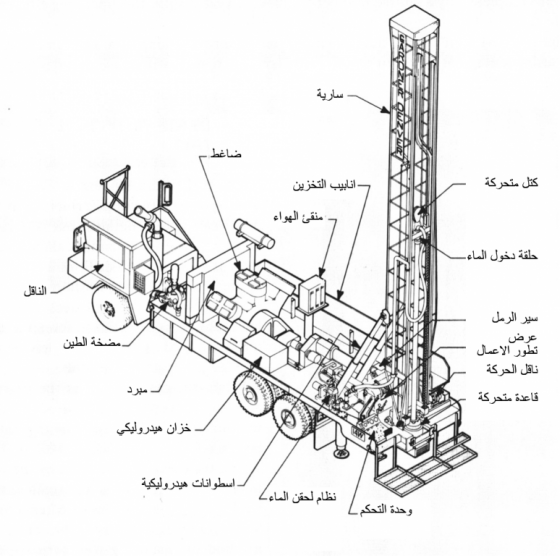
آلة حفر ميكانيكة كبيرة محمولة على مركبة للحفر. المصدر: WURZEL (2001)
الانتهاء من حفر البئر
يجب تركيب عدة عناصر بعد إنشاء الحفرة و قبل تشغيل البئر:
• غطاء البئر : يمنع الغطاء البئر من الانهيار وتسرب الملوثات. يتم استخدام أنابيب صلب تقليديا للبطانة لكنها استبدلت مؤخرًا بالأنابيب البلاستيكية، لأنها أقل تكلفة وأسهل في التعامل معها.
• حاجز البئر : يمنع الرواسب من التسلل للمياه داخل البئر. تحتاج فتحات الحاجز إلى أن تكون أصغر من حجم حبوب التراب المحيط بها. يمكن بسهولة شق الأنابيب البلاستيكية بمناشير قاطعة لعمل الآلاف من القطع الدقيقة.
• الحصى : تملأ مجموعة الحصى المكونة من الحصى الرملي والرمل الفراغ بين الحاجز والبئر. وهي مطلوبة فقط إذا كانت التربة المحيطة بها حجم حبوب أصغر من حجم فتحة الحاجز.
• الحاجز الصحي يعتبر طبقة غير منفذة للماء ، ويفضل أن تكون مصنوعة من الخرسانة لمنع تلوث البئر عن طريق تراجع التسرب من خلال مجموعة الحصى على طول البئر (WATERAID 2008; BALL 2001; WAL 2010).
• البنية الفوقية : تحمي الفتح على السطح وتمنع دخول الملوثات أو الجسيمات إلى البئر.
• المضخة
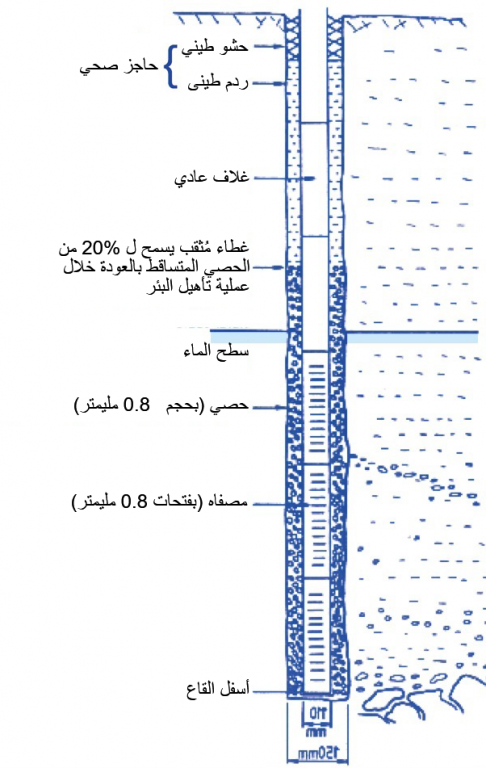
ملامح البئر المحفور. المصدر: WATERAID (2008)
تطوير واختبار البئر
وتغير جميع أساليب الحفر الخصائص الهيدروليكية لمواد التكوين في محيط البئر. وقد صممت إجراءات التطوير لاستعادة أو تحسين هذه الخصائص لتحقيق أقصى قدر من الأداء (SMET & WIJK 2002). ويتحقق ذلك من خلال إزالة الجسيمات الصغيرة وتوحيد مجموعة الحصى (WAL 2010). ويمكن أن يؤدي الإفراط في السحب (أي السحب فوق معدل التصميم) إلى تحسين كفاءة التعبئة عن طريق سحب المزيد من الجسيمات الدقيقة إليها. وحيث يوجد في الأرض المحيطة العديد من الجسيمات الدقيقة، يمكن تسريع تدفق المياه عن طريق ال الخلفي بمعدل أعلى (WATERAID 2008) (انظر إعادة تأهيل البئر).
بمجرد تطوير البئر وخلوه من الجسيمات الصغيرة، ينبغي اختبار ضخ البئر. يوفر اختبار الضخ معلومات مفيدة حول أداء البئر ويشير إلى ما إذا كان نتاج البئر كافي للغرض المقصود منه (WAL 2010). كما أنه يشير إلى أقصى عائد يمكن استخلاصه دون المخاطرة بالاستغلال المفرط للبئر. وبعد اختبار نوعية المياه (انظر أيضًا اختبار نوعية المياه، يمكن تشغيل البئر
التكاليف
وتقدر تكلفة الآبار التي يتم حفرها يدويًا من 20 إلى 3000 دولار أمريكي، اعتمادًا على الموقع والتكنولوجيا المستخدمة والجيولوجيا والهيدروجيولوجيا. وبالنظر إلى أن الآبار المحفورة تقليديًا (أي الآبار المحفورة ميكانيكيًا) في أفريقيا جنوب الصحراء الكبرى يمكن أن تتكلف ما بين 2.000 و 20.000 دولار أمريكي، فإن الحفر اليدوي كلما أمكن يمكن أن يوفر تكاليف كبيرة لتوفير إمدادات المياه في المناطق الريفية (DANERT 2009: HDD).تتكون مجموع التكاليف أساسًا من تكاليف البيانات، والمعدات ، والمركبات، والوقود، والمواد، والمواد الاستهلاكية، والعمالة. يتم تقديم طريقة لتقدير تكاليف البناء جيدًا في موقعك الخاص بمزيد من التفصيل بواسطة DANERT et al. (2010): التكاليف والسعر.
عادة ما تكون تكاليف تشغيل وصيانة البئر المحفور طفيفة، ما لم تكن هناك حاجة إلى تطوير البئر أو إعادة تأهيله بسبب حالة طارئة أو تلوثه أو خفض إنتاجه. تكاليف التشغيل والصيانة لـ الضخ اليدوي أو الضخ الميكانيكي هي التكلفة الرئيسية .
التشغيل والصيانة
وتشتمل عملية حفر الآبار على الضخ وتنظيف المنطقة المحيطة. يمكن لأعضاء المجتمع تشغيل البئر بأنفسهم بسهولة. لكن صيانة البئر المحفور تشمل الحفاظ على المضخة المزودة بالموتور أو الكهربائية أو المضخة اليدوية كذلك، الأمر الذي يحتاج إلى المزيد من المهارات والخبرات. إذا لم تعمل المضخة، فمن المستحيل استخراج المياه. أما بالنسبة لجميع مصادر المياه الجوفية ، فتعد الحماية ضرورية للحفاظ على نوعية المياه، وبالتالي فهي جزء لا يتجزأ من أي خطة صيانة.
الجوانب الصحية
بصفة عامة، تكون الآبار المحفورة أقل عرضة للتلوث بالمقارنة مع الآبار التقليدية ومع ذلك،فإن خطر إدخال الملوثات إلى المياه الجوفية عبر الحفرة نفسها مرتفع إلى حد كبير لا سيما في المناطق التي تشهد تطورًا سريعًا. تعد حماية البئر، على سبيل المثال. من خلال تركيب حاجز صحي مناسب غير منفذ للمواد بين الغلاف الدائم والتربة المحيطة أمرًا حيويًا لإمدادات المياه الآمنة على المدى الطويل (SMET & WIJK 2002). من السهل تركيب إجراءات حماية إضافية كالسقف والسياج لكنها فعالة جدًا في الحفاظ على نوعية المياه المناسبة. وفي حالة وجود تشكيلات صخرية تحتوى على الزرنيخ، فيمكن أن تؤدي عمليات الذوبان إلى تلوث طبيعي للمياه بالزرنيخ عندما تتعرض للأكسجين عند السطح تقنيات إزالة الزرنيخ ضرورية.
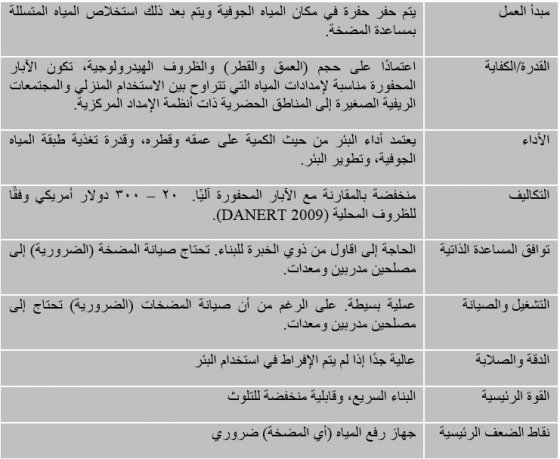
في جميع أنحاء العالم، تمد مئات الآلاف من الآبار المحفورة يدويًا لسكان الريف المياه لاغراض الزراعة، والصناعة و الاستخدام المنزلي. الحفر بطرق يدوية لآبار المياه للاستخدام المنزلي والإنتاجي يعد أمرًا شائعًا جدًا في معظم أنحاء بنجلاديش وعلى طول سهول الجانج في الهند. وفي أجزاء من أمريكا اللاتينية وأفريقيا، وقد أدخلت مؤخرًا تقنيات الحفر باليد. وفي بعض الحالات، كما في النيجر ونيجيريا، أصبح الحفر اليدوي جيدًا إلى حد ما (DANERT 2009). وعلى الرغم من الإمكانات الهائلة لتقنيات الحفر اليدوية لتوفير المياه بتكلفة منخفضة، إلا أنها غير مستغلة ومعروفة جيدًا لدى العديد من المهنيين في قطاع المياه والصرف الصحي والنظافة الصحية، وفي بعض الاحيان لا تعتبر مقبولة (DANERT 2009). الحفر اليدوي أيضًا جاذب للأستثمار حيث يمكن القيام به من قبل الشركات المحلية الصغيرة.
إلى جانب الحفر بطرق يدوية، يمكن أيضًا حفر الآبار ميكانيكيًا. تتراوح معدات الحفر بين آلات البسيطة والمتطورة جدًا والتى لديها القدرة على الحفر لاكثر من 200 متر في العمق (SMET & WIJK 2002).
خاصة في المناطق التي تعاني من ندرة مواد البناء والمعدات والقدرة المالية والمعرفية، فإن الحفر بطرق الميكانيكة يلعب دورا بسيطا فقط لأنه لا يختصر الوقت اللازم للبناء ولا يوفر الحلول منخفضة التكلفة.
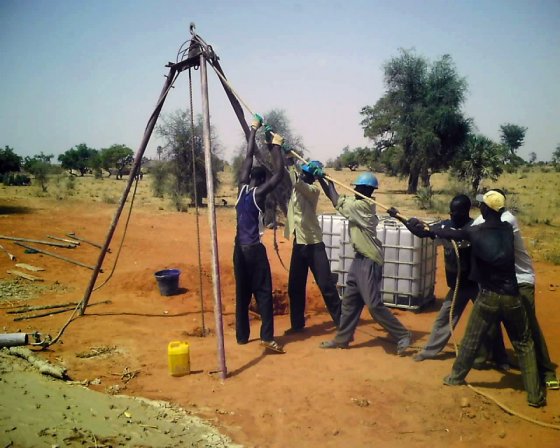
الحفر اليدوي (الحفر بالقرع) في النيجر. المصدر: NWFL (n.y.)
المبدأ الرئيسي للآبار المحفور بسيط: حيث يتم انشاء حفرة تصل الى مستوى المياه الجوفية و بعد ذلك يتم تجميع المياة المرتشحة داخل الحفرة بمساعدة مضخة سواء كانت يدويةl أو آلية. وبالمقارنة مع الأبار التقليدية، فإن أقطار الآبار المحفورة أصغر بكثير: وفي المناطق الريفية، تكون الآبار عادة قطرها 50 مم، في حين تتطلب الإمدادات الحضرية العالية التجريد ثقوبًا ذات قطر يصل إلى 300 مم (DANERT 2009; SMET & WIJK 2002). ومن حيث العمق ، ييتراوح عمق الآبار المحفورة يدويًا من الناحية الفنية ما يصل إلى 200 متر، على الرغم من أن الحد الأقصى لعمق الآبار المحفورة يدويًا والأكثر شيوعًا هو 35 مترًا. بالنسبة للآبار التي يتراوح عمقها أكثر من 50 مترًا، فإن الحفر اليدوي عمومًا لم يعد خيارًا مجديا مما يجعل الحفر بالطرق الميكانيكية ضرورياً.
ويعتمد أداء البئر من حيث الكمية على عمقه وقطره، وقدرة تغذية طبقة المياه الجوفية، وتطوير البئر. وبما أن المياه الجوفية هي عادة من المصادر الطبيعة لمياه الشرب، فإن المعالجة غالبًا لا تكون مطلوبة. ومع ذلك، تكون الآبار المحفورة عرضة للتلوث ما لم يتم تشغيلها وصيانتها وحمايتها بشكل صحيح .
أيضًا، يجب الاهتمام الجاد لمعدل سحب المياه من البئر . فيمكن أن يؤدي السحب على المكشوف إلى تأثيرات بيئية متنوعة :
• من الممكن ان يودى الى انخفاض مستوى المياة الجوفية بعيدًا عن متناول الآبار الموجودة المجاورة
• وقد تجف الأرض الرطبة
• فقدان الضغط الهيدروليكي يمكن أن يسبب انهيار الأرض وتشكيل الحفر مما يجعل الاستخدام الزراعي مستحيلًا
• قد يحدث تسريب لمياه البحر داخل المنسوب الجوفي اذا كان البئر موجودًا في المناطق الساحلية
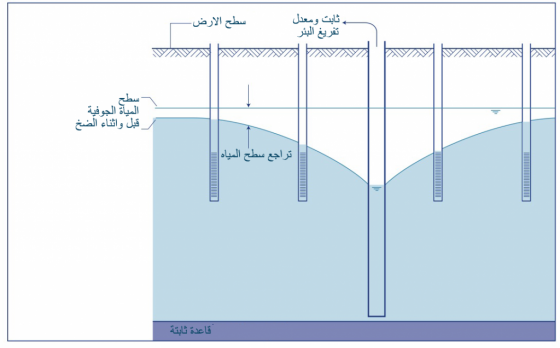
آثار سحب المياه الجوفية على الآبار المجاورة. المصدر: SMET & WIJK (2002)
مبادئ التصميم
تقييم مبدئي
قبل البدء في تصميم وتطوير أي نوع من مصادر المياه، يجب إجراء تقييم أولي من أجل إدارة المصادر المائية وتطويرها بفعالية وكفاءة. ويشمل هذا التقييم تقدير ميزان المياه (أي جمع البيانات الهيدرولوجية، وتحديد الوضع الحالي واتجاهات إمدادات المياه، وتحليل المدخلات والمخرجات، وتحليل تدفق المياه والمصادر ) و تقييم موارد المياه (أي التقييم والدراسة المنهجية لموارد المياه فيما يتعلق بالتأثير البشري، مثل تقييم الطلب، وتحديد المجاري المائية ، وتحليل استخدام المياه والجودة المطلوبة ). وعند تحليل جانب الطلب، تلعب قضايا تخصيص المياه دورًا حيويًا. وفي النهاية، يمكن أن يتطور هذا التقييم إلى خطة لتنمية مصادر المياه التى تصف حالة المصادر المائية وإدارتها وتطورها في المستقبل في منطقة معينة أو مستجمعات المياه.
يجب تقييم موقع البئر كخطوة أولى لبناءه. حيث أن تحديد موقع جيد للبئر يعد أمرًا حاسمًا لنجاحه واستدامته على المدى الطويل. ولا يتحدد الموقع عن طريق العوامل الفيزيائية فقط (مثل الجيولوجيا ، والهيدرولوجيا، والقرب من موقع الاستخدام الفعلي)، ولكن أيضًا بالعوامل المجتمعة "اللينة " (مثل القبول المجتمعى، وقدرات تشغيل وصيانة للبئر بما في ذلك المضخة، ونوع استخدام المياه، والعادات المحلية، وما إلى ذلك). ولهذا الغرض توجد العديد من الأساليب التي تتراوح بين حلول البسيطة والحلول التقنية الفائقة . ويمكن أن يكون اهل القرى وأفراد المجتمعات المجاورة مصدرًا جيدًا للحصول على معلومات عن وجود المياه الجوفية والمنسوب الجوفى بالمنطقة . كما يمكن أن تشير أنواع معينة من النباتات (مثل نباتات الموز والبقول وقصب السكر ونخيل التمر) إلى وجود المياه الجوفية (COLLINS 2000). وكثيرًا ما تشير الآبار الموجودة على مقربة شديدة إلى وجود المياه الجوفية. وفي حالة توفر المعدات التقنية، يمكن أن يوفر اختبار "بورينج " للتربة معلومات مفصلة عن مستوى المياه الجوفية. لمزيد من المعلومات التفصيلية انظر: CARTER et al. 2010.
من أجل الوصول إلى المياه الجوفية، يجب انشاء الحفرة وتركيب غطاء دائم لها . ويجب أن يشمل الحفر على :
• كسر أو قطع مكونات التربة
• إزالة المواد المقطوعة من الحفرة، وإذا لزم الأمر،
• تدعيم جدران الحفرة، لمنع الانهيار أثناء الحفر (WAL 2010).
• تشغيل اختبارات الضخ الاولية و تطوير البئر.
ولذلك، يوجد عدد كبير من التقنيات المختلفة. وعموما، هناك أربعة أنواع متميزة من الحفر اليدوي وهي: التثقيب، والقرع، وترسيب الطين ، والتدفق. (Cf. WAL 2010). وعلى نحو متزايد، تستخدم أكثر من تقنية أو اثنتين (DANERT 2009). ومع ذلك، من المهم أن ندرك أن حفر الآبار على العمق المطلوب وصولا الى طبقة المياه الجوفية وتطويرها بشكل صحيح سيكون مثمرًا بغض النظر عن طريقة الحفر (UNICEF 2010: التمويل).
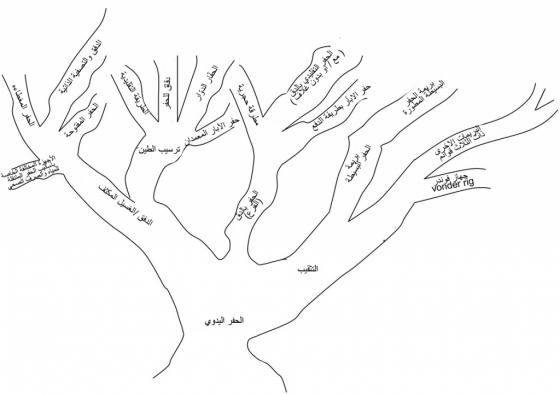
شجرة العائلة لطرق الحفر اليدوى المصدر: DANERT 2009(دليل الحفر اليدوي)
لا يعتمد اختيار تقنية الحفر الأمثل في الغالب على الظروف الجيولوجية والهيدرولوجية فقط، ولكن أيضًا على خبرة وتمويل المجتمعات المحلية أو مقاولي الحفر.
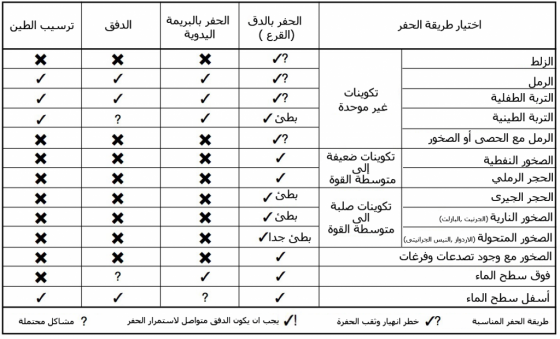
اختيار تقنية الحفر الأنسب. المصدر ELSON & SHAW (1995)
(مقتبس من WAL 2010)
يتكون المثقاب اليدوي من قضيب صلب قابلة للتمديد، يتم تدويره بواسطة مقبض. وهناك عدد من المثاقيب الصلبة المختلفة تدخل (تجويف الحفر) و يمكن تركيبها في نهاية قضبان الحفر. يتم تدوير بريمات الحفر في الأرض حتى يتم ملؤها، ثم يتم رفعها من البئر ليتم تفريغها.
واعلى مستوى المياة الجوفية ، تبقى فوهة البئر مفتوحة عمومًا دون الحاجة إلى الدعم. ويمكن استخدام جدار مؤقت لتثبيت و منع انهيار البئر تحت مستوى المياة . يستمر الحفر داخل الجدار المؤقت باستخدام نازح ( جردل او ما شابه) حتى يتم الوصول إلى العمق المطلوب. ثم يتم تثبيت جدار البئر الدائم ويجب إزالة الجدار المؤقت. يمكن استخدام بريمات حفر تصل إلى عمق حوالي 15-25 متر، اعتمادًا على جولوجية التربة . تتراوح الأقطار بين 50 إلى 200 ملليمتر.
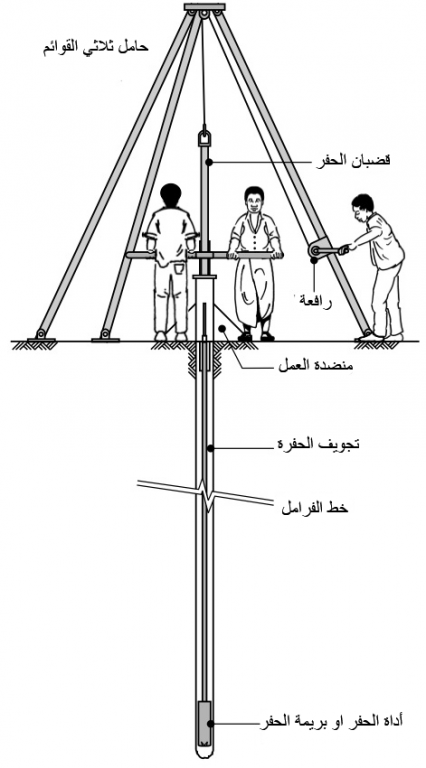
المصدر: ELSON & SHAW (1995)

يمكن أن تمد الآبار المحفورة المياه للأسر المعيشية الواحدة، اوللمجتمعات الريفية الصغيرة اوللمناطق الحضرية، وذلك حسب حجم البئر (العمق والقطر) والظروف الهيدرولوجية. إن الحفر اليدوي هو حل عملي ومنخفض التكلفة بالنسبة للآبار التي يقل عمقها عن 40 مترًا في التربة اللينة أو التكوينات الصخرية الناعمة (UNICEF 2010). تقنيات الحفر اليدوي المختلفة بسيطة ومتاحة وتناسب معظم الظروف الجيولوجية. ومع ذلك، هناك حاجة لفريق عمل من ذوي الخبرة وبعض المعدات للبناء.
يجب أن يؤخذ فى الاعتبار ان إنتهاء الانشاءات لا يضمن الحصول على الماء ، فالمياة لا تزال بحاجة إلى الرفع من الأرض والتوزيع بمساعدة مضخة يدوية أو مضخة ذات محرك ويجب ضمان الصيانة المناسبة لهذه الأجهزة (DANERT 2009).
الآبار المحفورة هي أقل عرضة لتلوث المياه الجوفية مقارنة بـ الآبار التقليدية. لكن لا تزال حماية البئر أمرًا حيويًا لتحسين نظام إدارة المياه المحلية الخاصة بك على المدى الطويل. إذا لم يتم الإفراط في سحب المياه ، لا يتوقع حدوث آثار كبيرة على البيئة. ومع ذلك، يجب إيلاء اهتمام خاص لمعدلات السحب إذا كان البئر موجودًا في المناطق الساحلية حيث أن المياه المالحة قد تدخل في البئر إذا كان الانشاء مرتفعًا جدًا.
Drilled Wells
This manual explains in practical terms the basic drilling techniques. It describes the use of fluid circulation in soft ground formations, and com- pressed air and hammers for hard rock. It discusses well design, types of pump and their installation, screen selection, and testing.
BALL, P. (2001): Drilled Wells. (= Series of Manuals on Drinking Water Supply , 6 ). St. Gallen: Swiss Centre for Development Cooperation in Technology and Management (SKAT) URL [Accessed: 11.03.2019] PDFSiting of Drilled Water Wells
This field note has been written for managers of water supply programmes and projects. It provides a step-by-step guide on the siting of drilled water wells. As a first step, the essential requirements for a simple groundwater model are set out, including some basic explanations to help the reader establish a sound understanding of hydrogeology.
CARTER, R. CHILTON, J. DANERT, K. OLSCHEWSKI, A. (2010): Siting of Drilled Water Wells. A Guide for Project Managers. St. Gallen: Rural Water Supply Network (RWSN) URL [Accessed: 11.03.2019] PDFHand-dug Shallow Wells
This highly recommended publication comprises everything regarding the establishment of a water supply system based on (shallow) hand-dug wells for communities in the South. It elaborates on the underlying hydrogeological principles, preparatory investigations, design, construction, operation and maintenance, and it discusses the most common mistakes made in design and construction.
COLLINS, S. (2000): Hand-dug Shallow Wells. (= Series of Manuals on Drinking Water Supply , 5 ). St. Gallen: Swiss Centre for Development Cooperation in Technology and Management (SKAT) URL [Accessed: 08.03.2019] PDFHand Drilling Directory
This document provides a short summary of each of the hand drilling techniques being utilised today; a country-by-country overview of the extent of hand drilling taking place in select countries; an annotated list of organisations involved in promoting and supporting hand drilling and an extensive list of literature, from published articles to training materials and online videos.
DANERT, K. (2009): Hand Drilling Directory. St. Gallen: Rural Water Supply Network (RWSN) URL [Accessed: 11.03.2019] PDFCode of Practice for Cost Effective Boreholes
The Code of Practice sets out nine principles that relate directly to the practicalities of borehole construction. They should be adhered to in order to provide cost-effective boreholes.
DANERT, K. ARMSTRONG, T. ADEKILE, D. DUFFAU, B. OUEDRAOGO, I. KWEI, C. (2010): Code of Practice for Cost Effective Boreholes. St. Gallen: Rural Water Supply Network (RWSN) URL [Accessed: 11.03.2019] PDFCosting and Pricing. A Guide for Water Well Drilling Enterprises
This field note is written for water well drilling enterprises as well as other agencies, which manage, or are involved in drilling projects. Using a step-by-step approach it gives clear guidance on how to cost and price the construction of drilled water wells. It also provides tips on business management with an emphasis of the realities faced in many countries in Sub-Saharan Africa.
DANERT, K. LUUTU, A. CARTER, R. OLSCHWESKI, A. (2010): Costing and Pricing. A Guide for Water Well Drilling Enterprises. St. Gallen: Rural Water Supply Network (RWSN) URL [Accessed: 11.03.2019] PDFHand drilling (percussion drilling) in Niger
Small Community Water Supplies: Technology, People and Partnership: Groundwater Withdrawal - Chapter 10
This book provides a general introduction to a wide range of technologies. Among the topics covered are: planning and management of small water supplies, community water supplies in Central and Eastern European countries, water quality and quantity, integrated water resources management, artificial recharge, rainwater harvesting, spring water tapping, groundwater withdrawal, water lifting, surface water intake, water treatment, aeration, coagulation and flocculation, sedimentation, multi-stage filtration, desalination technology, disinfection, household level water treatment, technologies for arsenic and iron removal from ground water, and emergency and disaster water supply. Chapter 10: Groundwater Withdrawal
SMET, J. ; WIJK, C. van (2002): Small Community Water Supplies: Technology, People and Partnership: Groundwater Withdrawal - Chapter 10. The Hague: International Water and Sanitation Centre (IRC) URL [Accessed: 08.03.2019] PDFFinancing Options for Low-cost Well Drillers & Communities for Rural Water Supply
The purpose of this manual is to provide straightforward financing guidance to “low cost well drilling enterprises” involved in water well drilling operations, as well as to village and community groups, individual, and NGOs (“community customers”) intending to borrow the necessary capital to hire services from such well drilling enterprises.
UNICEF (2010): Financing Options for Low-cost Well Drillers & Communities for Rural Water Supply. New York: UNICEF URL [Accessed: 21.03.2012] PDFUnderstanding Groundwater & Wells in Manual Drilling. Instruction Handbook for Manual Drilling Teams on Hydro-geology for Well Drilling, Well Installation and Well Development
The manual ‘Understanding Groundwater & Wells in manual drilling’ complements the 4 technical training handbooks and highlights those essential subjects which are relevant to manual drilling, geo-hydrology, hygiene, well installation and well development in practice, in simple and understandable language.
WAL, A. van der (2010): Understanding Groundwater & Wells in Manual Drilling. Instruction Handbook for Manual Drilling Teams on Hydro-geology for Well Drilling, Well Installation and Well Development. Papendrecht: PRACTICA Foundation URL [Accessed: 21.03.2012] PDFTechnology Notes
These technology notes have been prepared following many general enquiries for technical information having been received by WaterAid over the years. Their purpose is to give an outline of the technologies used by WaterAid on long-term development projects in Africa and Asia, and to show alternatives, which might be appropriate in different circumstances. It may be possible to determine from the notes the technology, which would be appropriate in a particular location.
WATERAID (2008): Technology Notes. London: WaterAid URL [Accessed: 04.01.2011] PDFDrilling Boreholes for Handpumps
This booklet seeks to suggest ways in which funds can be better used for making safe water available to the poor by illustrating how drilling costs can be reduced without compromising water quality, water quantity, or the productive life of the borehole.
WURZEL, P. (2001): Drilling Boreholes for Handpumps. (= Working Papers on Water Supply and Environmental Sanitation , 2 ). St. Gallen: Swiss Centre for Development Cooperation in Technology and Management (SKAT) URL [Accessed: 11.03.2019] PDFدراسة خصائص المياه الجوفية في منطقة وادي الشاطئ وتقييم التأثيرات لتدهور نوعيتها. كلية العلوم الهندسية والتقنية- جامعة سبها, الجماهيرية العربية الليبية
Language: Arabic
ﺘﻘﻴﻴﻡ ﺍﻟﻤﻴﺎﻩ ﺍﻟﺠﻭﻓﻴﺔ ﻟﺒﻌﺽ ﺁﺒﺎﺭ ﻗﺭﻴﺔ ﺍﻟﺨﻔﺎﺠﻴﺔ ﻓﻲ ﻤﺤﺎﻓﻅﺔ ﺍﻷﻨﺒﺎﺭ.مجلة جامعة الأنبار للعلوم الصرفة.المجلد الثالث.العدد الثاني. ﺠﺎﻤﻌﺔ ﺍﻟﻤﻭﺼل.العراق
Drilled Wells
This manual explains in practical terms the basic drilling techniques. It describes the use of fluid circulation in soft ground formations, and com- pressed air and hammers for hard rock. It discusses well design, types of pump and their installation, screen selection, and testing.
BALL, P. (2001): Drilled Wells. (= Series of Manuals on Drinking Water Supply , 6 ). St. Gallen: Swiss Centre for Development Cooperation in Technology and Management (SKAT) URL [Accessed: 11.03.2019] PDFSiting of Drilled Water Wells
This field note has been written for managers of water supply programmes and projects. It provides a step-by-step guide on the siting of drilled water wells. As a first step, the essential requirements for a simple groundwater model are set out, including some basic explanations to help the reader establish a sound understanding of hydrogeology.
CARTER, R. CHILTON, J. DANERT, K. OLSCHEWSKI, A. (2010): Siting of Drilled Water Wells. A Guide for Project Managers. St. Gallen: Rural Water Supply Network (RWSN) URL [Accessed: 11.03.2019] PDFHand Drilling Directory
This document provides a short summary of each of the hand drilling techniques being utilised today; a country-by-country overview of the extent of hand drilling taking place in select countries; an annotated list of organisations involved in promoting and supporting hand drilling and an extensive list of literature, from published articles to training materials and online videos.
DANERT, K. (2009): Hand Drilling Directory. St. Gallen: Rural Water Supply Network (RWSN) URL [Accessed: 11.03.2019] PDFCode of Practice for Cost Effective Boreholes
The Code of Practice sets out nine principles that relate directly to the practicalities of borehole construction. They should be adhered to in order to provide cost-effective boreholes.
DANERT, K. ARMSTRONG, T. ADEKILE, D. DUFFAU, B. OUEDRAOGO, I. KWEI, C. (2010): Code of Practice for Cost Effective Boreholes. St. Gallen: Rural Water Supply Network (RWSN) URL [Accessed: 11.03.2019] PDFCosting and Pricing. A Guide for Water Well Drilling Enterprises
This field note is written for water well drilling enterprises as well as other agencies, which manage, or are involved in drilling projects. Using a step-by-step approach it gives clear guidance on how to cost and price the construction of drilled water wells. It also provides tips on business management with an emphasis of the realities faced in many countries in Sub-Saharan Africa.
DANERT, K. LUUTU, A. CARTER, R. OLSCHWESKI, A. (2010): Costing and Pricing. A Guide for Water Well Drilling Enterprises. St. Gallen: Rural Water Supply Network (RWSN) URL [Accessed: 11.03.2019] PDFSmall Community Water Supplies: Technology, People and Partnership: Groundwater Withdrawal - Chapter 10
This book provides a general introduction to a wide range of technologies. Among the topics covered are: planning and management of small water supplies, community water supplies in Central and Eastern European countries, water quality and quantity, integrated water resources management, artificial recharge, rainwater harvesting, spring water tapping, groundwater withdrawal, water lifting, surface water intake, water treatment, aeration, coagulation and flocculation, sedimentation, multi-stage filtration, desalination technology, disinfection, household level water treatment, technologies for arsenic and iron removal from ground water, and emergency and disaster water supply. Chapter 10: Groundwater Withdrawal
SMET, J. ; WIJK, C. van (2002): Small Community Water Supplies: Technology, People and Partnership: Groundwater Withdrawal - Chapter 10. The Hague: International Water and Sanitation Centre (IRC) URL [Accessed: 08.03.2019] PDFFinancing Options for Low-cost Well Drillers & Communities for Rural Water Supply
The purpose of this manual is to provide straightforward financing guidance to “low cost well drilling enterprises” involved in water well drilling operations, as well as to village and community groups, individual, and NGOs (“community customers”) intending to borrow the necessary capital to hire services from such well drilling enterprises.
UNICEF (2010): Financing Options for Low-cost Well Drillers & Communities for Rural Water Supply. New York: UNICEF URL [Accessed: 21.03.2012] PDFImproving Skills of Manual Drilling Enterprises. Business Management
This manual has been devised as a training guide for small businesses specialised in manual drilling and related businesses such as those specialising in pump making and pump repair.
UNICEF (2010): Improving Skills of Manual Drilling Enterprises. Business Management. New York: UNICEF URL [Accessed: 21.03.2012] PDFProfessionalizing the Manual Drilling Sector in Africa. A Guide to Building Capacity to Increase Access to Safe Water in Rural Areas
The purpose of this manual is to assist UNICEF Country Offices and others interested in promoting the emergence of a professional manual drilling sector in their country of operation. The manual provides a step-by step methodology, based on experiences in Niger, Chad and Senegal, for the promotion of a local professional manual drilling sector.
UNICEF (2010): Professionalizing the Manual Drilling Sector in Africa. A Guide to Building Capacity to Increase Access to Safe Water in Rural Areas. New York: UNICEF URL [Accessed: 21.03.2012] PDFUnderstanding Groundwater & Wells in Manual Drilling. Instruction Handbook for Manual Drilling Teams on Hydro-geology for Well Drilling, Well Installation and Well Development
The manual ‘Understanding Groundwater & Wells in manual drilling’ complements the 4 technical training handbooks and highlights those essential subjects which are relevant to manual drilling, geo-hydrology, hygiene, well installation and well development in practice, in simple and understandable language.
WAL, A. van der (2010): Understanding Groundwater & Wells in Manual Drilling. Instruction Handbook for Manual Drilling Teams on Hydro-geology for Well Drilling, Well Installation and Well Development. Papendrecht: PRACTICA Foundation URL [Accessed: 21.03.2012] PDFDrilling Boreholes for Handpumps
This booklet seeks to suggest ways in which funds can be better used for making safe water available to the poor by illustrating how drilling costs can be reduced without compromising water quality, water quantity, or the productive life of the borehole.
WURZEL, P. (2001): Drilling Boreholes for Handpumps. (= Working Papers on Water Supply and Environmental Sanitation , 2 ). St. Gallen: Swiss Centre for Development Cooperation in Technology and Management (SKAT) URL [Accessed: 11.03.2019] PDFCleaning and Rehabilitating Boreholes
This technical note sets out the actions required to repair and rehabilitate a borehole after any disaster.
GODFREY, S. REED, B. (2013): Cleaning and Rehabilitating Boreholes. (= Technical Notes on Drinking-Water, Sanitation and Hygiene in Emergencies , 2 ). Geneva: World Health Organization (WHO) URL [Accessed: 26.08.2013] PDFThe Drilling Environment and Establishing a Drillers Association in Nigeria. Summary Report
RWSN, with support of the Water and Sanitation Programme of the World Bank (WSP-AF) is supporting the formation of a Nigerian Drillers Association. This report provides an overview of the Nigerian drilling environment and sets out the first stage of the process of establishing the association.
ADEKILE, D. (2007): The Drilling Environment and Establishing a Drillers Association in Nigeria. Summary Report. St. Gallen: Rural Water Supply Network (RWSN) URL [Accessed: 11.03.2019] PDFRationalization of Drilling Operations in Tanzania. Review of the Borehole Drilling Sector in Tanzania
This study reviews the situation in the drilling sector in Tanzania, assesses options, and identifies support areas.
BAUMANN, E. BALL, P. BEYENE, A. (2005): Rationalization of Drilling Operations in Tanzania. Review of the Borehole Drilling Sector in Tanzania. St. Gallen: Rural Water Supply Network (RWSN) URL [Accessed: 11.03.2019] PDFTen-step Guide Towards Cost-effective Boreholes. Case Study of drilling costs in Ethiopia
Increasing access to groundwater is a high priority in Sub-Saharan Africa. One key to this is to reduce the costs of conventional drilling and borehole construction. This field note, describing a recent study in Ethiopia, sets out how this may be done.
CARTER, R. (2006): Ten-step Guide Towards Cost-effective Boreholes. Case Study of drilling costs in Ethiopia. St. Gallen: Rural Water Supply Network (RWSN) URL [Accessed: 11.03.2019] PDFA Brief History of Hand Drilled Wells in Niger. Only the Beginning
This field note describes the history of hand drilling and water-lifting techniques introduced in Niger over 30 years ago and now firmly in the hands of local enterprises, farmers and household water users. Recommendations for the way forward are included.
DANERT, K. (2006): A Brief History of Hand Drilled Wells in Niger. Only the Beginning. St. Gallen: Rural Water Supply Network (RWSN) URL [Accessed: 21.03.2012] PDFBurkina Faso: Summary of Findings of 2009 Study and Draft National Code of Conduct. Code of Practice for Cost-Effective Boreholes
This report provides a summary of the study on how to optimise the costs of boreholes construction in Zambia, Ghana and Burkina Faso.
DUFFAU, B. OUEDRAOGO, I. (2009): Burkina Faso: Summary of Findings of 2009 Study and Draft National Code of Conduct. Code of Practice for Cost-Effective Boreholes. St. Gallen: Rural Water Supply Network (RWSN) URL [Accessed: 11.03.2019] PDFThe Impact of Manual drilling for the Construction of Sustainable Water-Points in Chad. Case Study
This case study examines the impact of professional manual drilling operations on the problem of increasing the rate of delivery of improved water supply in Chad.
UNICEF (2009): The Impact of Manual drilling for the Construction of Sustainable Water-Points in Chad. Case Study. New York: UNICEF URL [Accessed: 21.03.2012] PDFImproving Cost Effectiveness of Drilling Programmes in Mozambique and Zambia
The Rural Water Supply Network (RWSN), in collaboration with UNICEF, recently published a Code of Practice for Cost Effective Boreholes. This document outlines principles that provide a basis for the realisation of economical and sustainable access to safe water through the construction of boreholes in Sub-Saharan Africa. Evaluation of these principles in specific countries underlined the importance of improved contractual procedures and technical specifications for significant reductions in drilling costs.
UNICEF (2011): Improving Cost Effectiveness of Drilling Programmes in Mozambique and Zambia. New York: UNICEF PDFSelf-Supply as a Complementary Water Services Delivery Model in Ethiopia
Self-supply, where households invest to develop their own easily-accessible water supplies, is identified as an alternative service delivery model that is potentially complementary to more highly subsidised community-level provision. The approach is widespread in Ethiopia with family wells bringing additional benefits that are in line with wider government objectives, such as supporting small-scale irrigation. However, two recent studies show the current performance of traditional or family wells to be far below potential with most sources providing unsafe water in the absence of adequate protection.
BUTTERWORTH, J. ; SUTTON, S. ; MEKONTA, L. (2013): Self-Supply as a Complementary Water Services Delivery Model in Ethiopia. المُدخلات: Water Alternatives: Volume 6 , 405-423. URL [Accessed: 08.03.2019] PDFCode of Practice for Cost Effective Boreholes
The Code of Practice sets out nine principles that relate directly to the practicalities of borehole construction. They should be adhered to in order to provide cost-effective boreholes.
DANERT, K. ARMSTRONG, T. ADEKILE, D. DUFFAU, B. OUEDRAOGO, I. KWEI, C. (2010): Code of Practice for Cost Effective Boreholes. St. Gallen: Rural Water Supply Network (RWSN) URL [Accessed: 11.03.2019] PDFTechnical Review. Borehole Drilling and Rehabilitation under Field Conditions
This technical review presents and synthesises an impressive amount of practical experience in the field of borehole drilling and rehabilitation.
ICRC (2010): Technical Review. Borehole Drilling and Rehabilitation under Field Conditions. Geneva: International Committee of the Red Cross (ICRC) URL [Accessed: 21.03.2012] PDFTechnical Review. Practical Guidelines for Test Pumping in Water Wells
The practical guidelines for test pumping presented in this publication reflect years of hands-on experience in borehole exploitation in both rural and urban settings, from Africa to the Middle East and Asia.
ICRC (2011): Technical Review. Practical Guidelines for Test Pumping in Water Wells. Geneva: International Committee of the Red Cross (ICRC) URL [Accessed: 21.03.2012] PDFManual Drilling Series: Augering. Technical Training Handbook on Affordable Manual Well Drilling
This handbook describes the hand auger technique. This cheap and effective technique is very suitable for sinking shallow wells in soft soils and is excellent for soil surveys. Many drilling teams have this technique in their toolkit to complement other drilling techniques.
LABAS, J. VUIK, R. (2010): Manual Drilling Series: Augering. Technical Training Handbook on Affordable Manual Well Drilling. Papendrecht: PRACTICA Foundation URL [Accessed: 21.03.2012]Manual Drilling Series: Jetting. Technical Training Handbook on Affordable Manual Well Drilling
This handbook describes the various jetting techniques in detail that can be used to drill wells in loose and soft soil formations. With this technique, wells are drilled in a few hours rather than days.
VUIK, R. (2010): Manual Drilling Series: Jetting. Technical Training Handbook on Affordable Manual Well Drilling. Papendrecht: PRACTICA Foundation URL [Accessed: 21.03.2012] PDFManual Drilling Series: Percussion. Technical Training Handbook on Affordable Manual Well Drilling
This handbook describes the percussion technique in detail. Although the technique is slower than other drilling techniques, it is the only manual drilling technique that is able to drill through consolidated rock layers.
VUIK, R. KONING, D. de WAL, A. van der (2010): Manual Drilling Series: Percussion. Technical Training Handbook on Affordable Manual Well Drilling. Papendrecht: PRACTICA Foundation URL [Accessed: 21.03.2012] PDFDrainage from Water Points
This poster is part of the series of Water, Sanitation and Hygiene posters designed by the Water, Engineering and Development Center of Loughborough University.
SKINNER, B.H. CHATTERTON, K. SHAW, R. (2013): Drainage from Water Points. Poster. (= WEDC Posters , 7 ). London: Water, Engineering and Development Center (WEDC) URL [Accessed: 28.08.2013] PDFA Water Handbook
The Water Handbook is the result of wide collaboration within UNICEF. It provides a broad overview of state-of-the-art programming for water management, protection and supply.
UNICEF (1999): A Water Handbook. (= Water, Environment and Sanitation Technical Guidelines , 2 ). New York: United Nations Children’s Fund (UNICEF) URL [Accessed: 08.03.2019] PDFManual Drilling
The Rural Water Supply Network is a global knowledge network for rural water supply technologies and approaches. The website provides many excellent publications on various topics on rural development, particularly on hand drilled wells. This section presents an overview of the scale and type of hand drilling activity being undertaken in selected countries and the organisations involved.
Technical Note Series on Manual Drilling
UNICEF, Practica and Enterprise Works/VITA have developed a toolkit for African countries aiming to embark on the professionalisation of manual drilling. This comprehensive toolkit includes technical notes, technical manuals, advocacy materials, mapping of suitable areas for manual drilling, case studies, and implementation and training manuals.
European Soil Data Centre (ESDAC)
The choice of drilling technique and well type crucially depends on local geology. This website provides detailed soil maps of Africa and Asia, among others.


